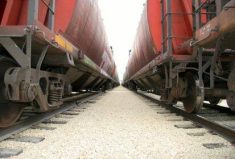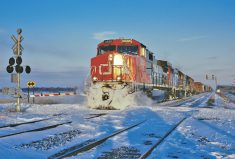CN and CP won’t face penalties for exceeding their revenue caps in the crop year that ended July 31, even though farmers paid about $6 per tonne above those caps to ship their grain.
The railways collectively were $5.4 million or 17 cents a tonne under the Canadian Transportation Agency’s (CTA) revenue cap of almost $923.4 million or $28.93 a tonne, the CTA said in a news release Dec. 21.
The Canadian National Railway Company (CN) earned almost $463.9 million or $29.41 a tonne, which was 33 cents a tonne under its cap of $29.74 a tonne.
Read Also

University of Manitoba honours three agriculture alumni
Cathey Day, Fred Greig and Kim McConnell were chosen for the University of Manitoba’s 2025 certificates of merit from the agricultural and food sciences faculty.
Canadian Pacific Railway (CPR) was almost 10 cents a tonne under its revenue cap of $455.7 million or $28.23 a tonne.
It’s the first time since 2002-03 that neither railway has exceeded the cap, but some observers are saying it’s more a result of “slick” accounting than keeping farmers’ transportation costs in check.
ABOVE THE CAP
Quarterly reports from Quorum Corporation, hired to monitor the grain handling and transportation system, show farmers paid around $35 a tonne for freight – about $6 a tonne above the railway revenue caps.
That’s because the railways are allowed certain deductions from what counts as revenue, such as the cost of offering incentives to grain companies for loading 50- and 100-car spots, which are then passed back to farmers as trucking premiums.
It makes sense for the railways to reward efficient shippers by sharing some of their savings, said Canadian Wheat Board director and Eston, Sask. farmer Bill Woods.
However, Woods takes issue with how those incentives are used to skew the revenue cap calculations.
A study by Travaco Research found that although loading 100-car trains saves the railways only $2 a tonne, the railways are giving $8 discounts. It seems absurd, but not when the railways can deduct it from what counts as revenue under the cap, Woods said.
“There are about $100 million paid out annually in multicar incentives,” Woods said. “So that means, because the railroads are able to deduct that, their revenue can be $100 million higher.”
“So in reality they are well above the revenue cap.”
FARMERS’ OWN MONEY
Looked at another way, the incentive money the railways pay elevators for loading 100-car trains is really the farmer’s own money, Woods said.
The grain companies use the money through trucking premiums to encourage farmers to deliver to their elevators, often bypassing a short line railway or a smaller elevator and adding to highway wear and tear. “It is definitely distorting the true economics,” he said.
“It’s almost like a subsidy to the large concrete elevators. When farmers get a trucking premium, they’re only getting their own money back.
“Farmers paying their own trucking premiums – they (railways) are pretty slick, aren’t they?”
One railway expert, who asked not to be named, said this crop year farmers are paying the railways about $37 a tonne, on average, to move grain even though the cap is $31.
The other issue farmers have with the revenue cap is that it’s based on what it cost the railways to move grain in 1992 – the last time a full costing review was done.
When the cap was introduced, the rai lways were allowed to earn their costs plus 27 per cent. A Travacon Research study estimates the railways, benefiting from a much more streamlined and efficient system get their costs plus a 50 or 60 per cent return.
REVIEWS NEEDED
That’s all the more reason for a review of how much it costs the railways to move grain and their allowable deductions.
Woods said he suspects calls for a costing review may have encouraged the railways not to exceed the revenue cap in 2009- 10.
In the previous crop year (2008-09) the railways collectively exceeded the cap by almost $466,000 or one cent a tonne.
However, in 2007-08 the railways exceeded the cap by a whopping $57.9 million or $2.21 a tonne.
Under the Canadian Transportation Act railway earnings from grain shipping that exceed the cap must be paid to the Western Grain Research Foundation, plus penalties. The money is used for grain research. [email protected]
Source: Canadian Transportation Agency
———
“Farmerspayingtheir owntruckingpremiums– they(railways)arepretty slick,aren’tthey?”
– BILL WOOD
———
Year2009-10
CPRAILWAY REVENUE CAPS COMPARED TO ACTUAL REVENUE FROM SHIPPING GRAIN
CN
Total
CN
Avg.
Miles hauled
1,040
916
977
1,040
916
Rev. capActual revenue
$467,654,362 $463,919,885
$455,725,757 $454,043,873
$923,380,119 $917,963,758
$29.74/mt
$28.23/mt
$28.93/mt $29.41/mt
$28.13/mt
$28.76/mt under/over
cap/mt
$3,734,477 under
$1,681,884 under
$5,416,361 under
$0.33/mt
under
$0.10/mt under
$0.17/mt under



















